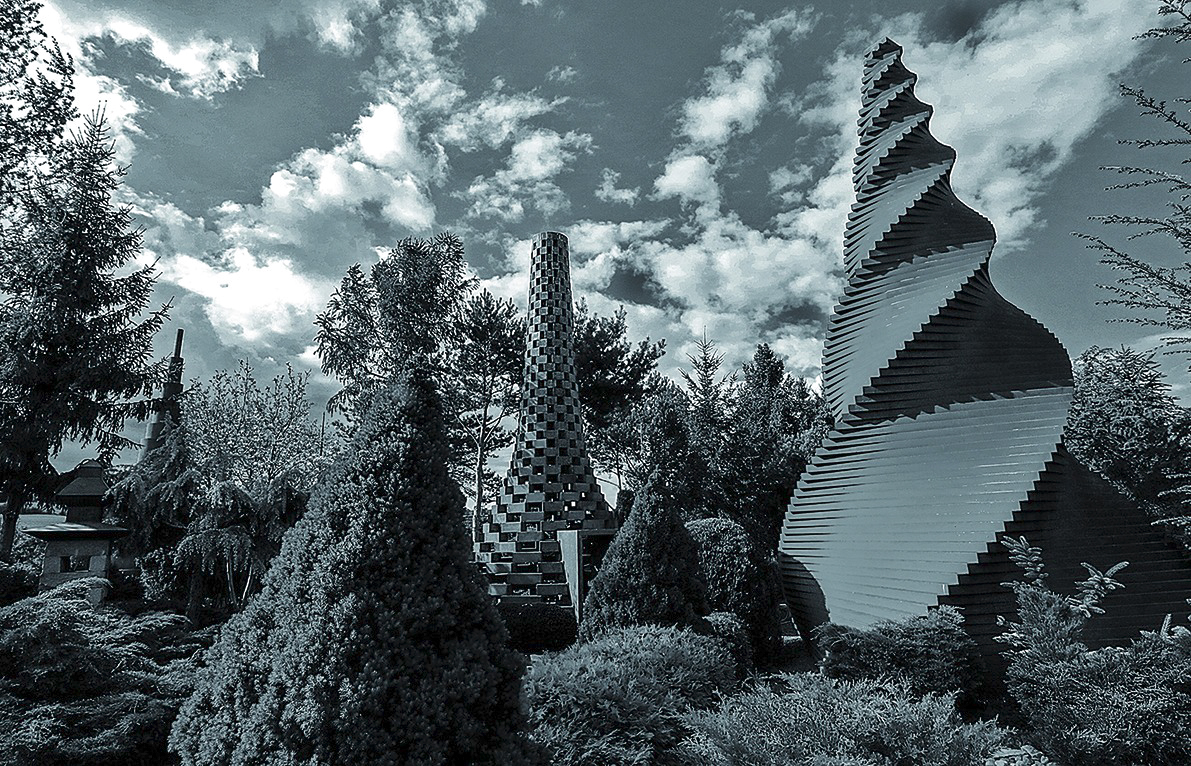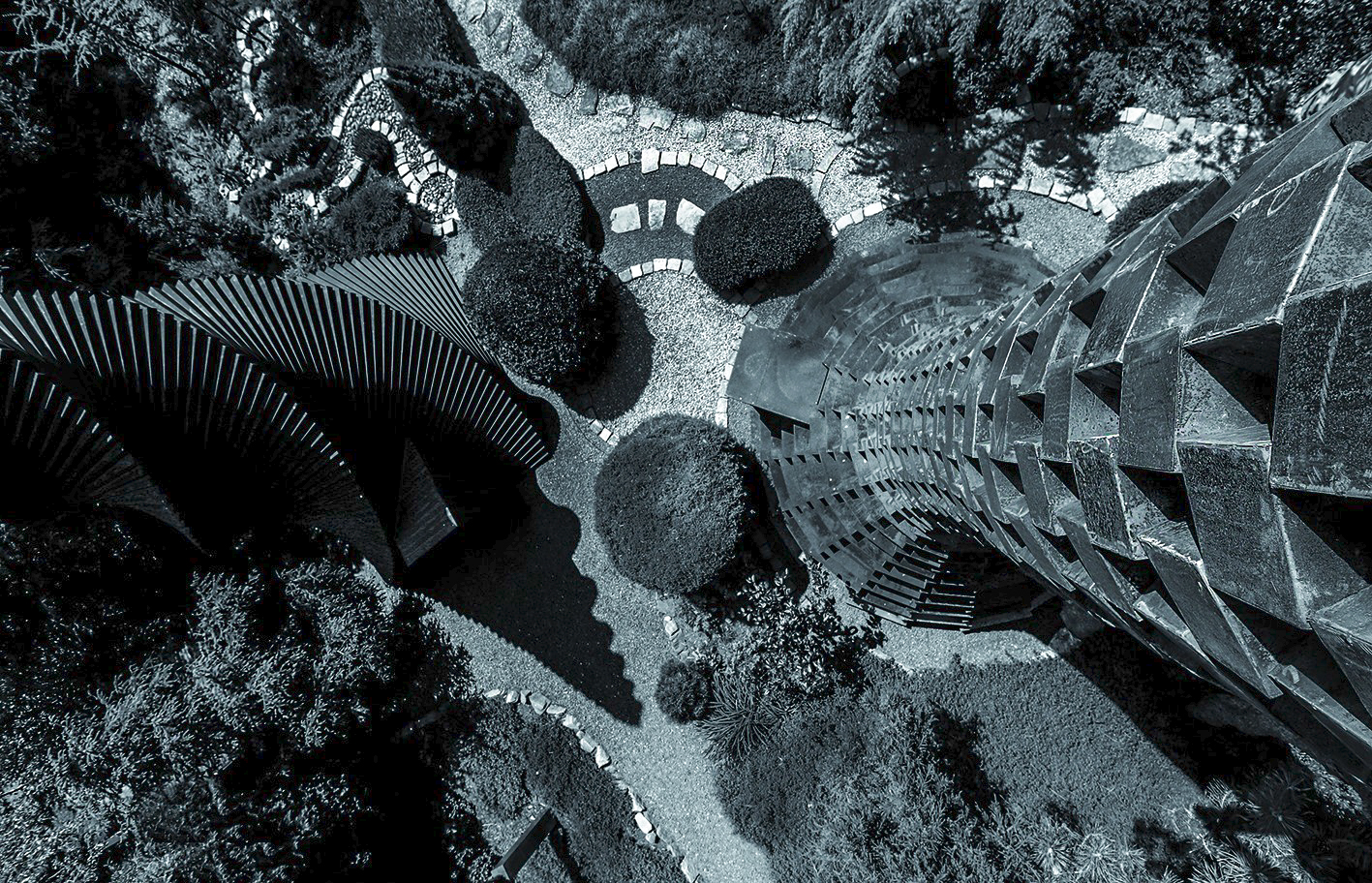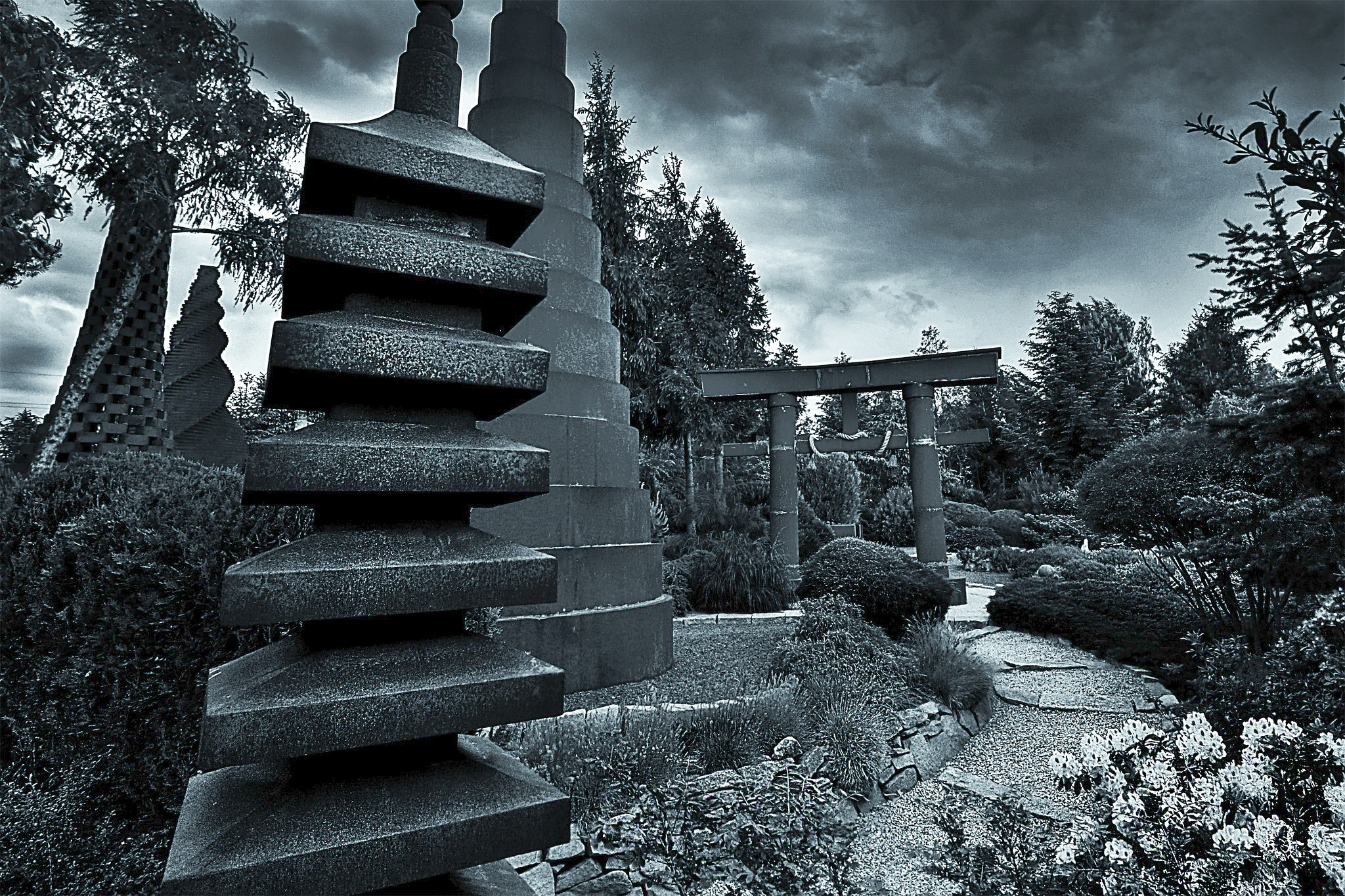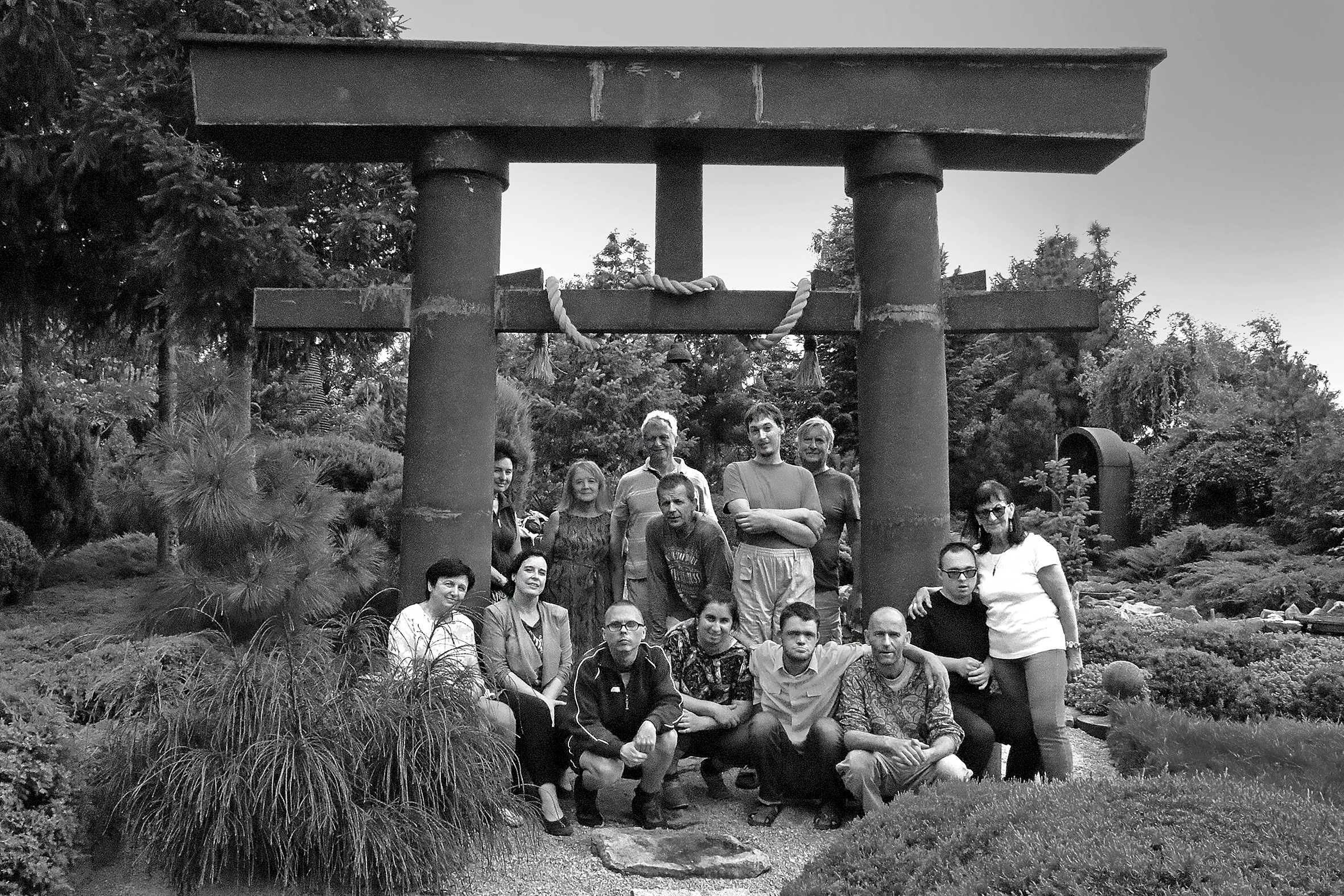TowerTopia has been created as a space where art, creativity and nature coexist, giving a shelter to many species of flora and fauna in this oasis on the edge of the farmlands. The creators of the garden setting strives to make the horticultural, artistic experiences accessible to communities within Lower Silesia region. Planning and building signifies human responsibility for creating the public and private spaces and then looking after that, which exists for the order of beauty of space.
TowerTopia is a space where art, creativity and nature coexist, giving a shelter to many species of flora and fauna in this oasis on the edge of the farmlands. The project is about reclaiming universal beauty and function of the gardens' order in relation with pledge for ecological conscious, while gardening, and posing the questions about biodiversity and forthcoming needs of introduction new species endure to survive. Both cultural and agricultural issues, made this location as part of innovative rural touring network. This private garden setting strives to make the horticultural, artistic experiences accessible to communities within Lower Silesia region and make as shared experience. Planning and building in TowerTopia signifies human responsibility for creating the public and private spaces and then looking after that which exists. The hedera green wall, as part of the arrangement, allows for the bees to dwell and requires coexistence and care. TowerTopia is dedicated to all, not only creators of the "other spaces" both private and public but even more those, who are not yet feel encouraged to be involved. The inclusion is a process of awaking the wish and provide some good practises. TowerTopia’s goal is to build on natural human inclusion to the nature. The offer of symbiotic relationship between the art of gardening and fine arts has been presenting as a specific garden democracy - we can contemplate their interrelations with equal engagement in expansive parks and in miniature ecosystems enclosed in a jar. The project presents the merge of nature's beauty and abstract thinking about minimalist art forms in the garden as an example of narratives supporting social inclusion and the assumptions of the reclaiming natural setting. But it is also centred around power of creativity, contributing to building social cohesion and developing a shared sense of responsibility for the beauty of space around us.
Please highlight how the project can be exemplary in this context
The specific key goal of completing TowerTopia was the responsible art-driven planning and building, reaching sustainability not only in the professional architectural realizations but also in the private spaces. Because of its location, the project particularly supports regeneration and transformation of the rural area. In TowerTopia the organic garden and non-organic sculptural elements are merged with the respect to the horticultural rules to secure growth; biodiversity and water management. It is the materialised voice in the quest for sustainability. The project covers setting the contacts with the University of Agriculture and teaching about the nature-based solutions. Moreover, foreseeing the local climate trends, related to the introduction of non-endemic species, which will adapt and endure in the unfavourable weather conditions. In this sense the place is playing the role of a "testbed" pool showing good examples as well as wrongs and mistakes to be shared with visitors and social media followers. The observations leads us to the assumptions, that the popularization of more specific knowledge about the green walls photosynthesis, oxygen production and airborne dust particles absorption, the problems with maintaining the health of bees, biological balance and planting new species to replace those dying such as spruce, is required. The green wall and the tanks for catching rainwater have been installed in TowerTopia accordingly to the needs for increasing watering. In times of growing local and global crises, it is rural areas that are in front trends that are an important element in building sustainable human environments.
Please highlight how the project can be exemplary in this context
We believe, that sculptural objects in the garden have an impact on better understanding and appreciation of esthetical objects. The project aimed at presenting of a specific, orderly space that compensates for the chaos and disorder of the world and are meant for the shared collective experience. This objective is a moving target therefore the educational program will evolve in direction of “project making” to organize in-situ workshops about the esthetical installation. Firstly, the creating of architectural towers inscribed in the garden and landscape borrowed from the surrounding hills, secondly, an idea of changing the popular vision of garden architecture to alternative approaches is being implemented. The towers of TowerTopia are bearing the quality of experience beyond functionality offering the contemplative area maintaining relations – no matter how peculiar – with the world. What counts is the imperative to create, but above all, the symbiotic relationship between the culture and nature. H.G. Gadamer points out that “art is knowledge and experiencing an artwork means sharing in that knowledge”. After completion in the end of 2020, TowerTopia has been presented during the symposium on modern gardens in Wroclaw National Museum. The place is well connected with Wroclaw – capitol of Lower Silesia region, and being a kind of satellite of this cultural centre can rely of the support of cultural institutions, who help to gain the recognition of the place, through exhibitions, research and social activities. With the TowerTopia project, the DIS foundation takes part in the alternative cultural development of the local community and aesthetics of the region.
Please highlight how the project can be exemplary in this context
What problems are the inhabitants of post-communist villages are facing today? Can we use the potential of rural life? The collective agriculture, introduced in 50-ties, devastated mostly the true spirit of collaboration, which has to be now restored with the common experience of “togetherness”. Both and sustainability experiences, work on successful reinforcement of the confidence of people from rural societies. The operation of this TowerTopia garden is therefore aimed at influencing the social capital and identity of the inhabitants of the county, by opening for them the TowerTopia zone and make this place known also for the people from elsewhere. Regeneration of the former fallow lands has an impact that goes well beyond what can be measured in economic terms. By enabling people of all ages to observe and also encourage to take part in their own creativity. A space for emotional experience created, and the feeling of pleasure. Another important aspect of the place is "suspension" of Silesia between Polish and German cultures. TowerTopia is asking questions about the quality and planning of rural gardens and how to organize them in the future at the junction of private and public space in the inclusive way to show the countryside not as a closed, divided, privatized space, but as a space of ideas - community, the shape of which is influenced by each of the inhabitants. The garden democracy concept has been developed throughout the project. It's aesthetic power is not measured in terms of square meters or cubits of soil but in the degree of engagement on the part of the maker. This is an invitation to attentiveness that is available-to-hand and opens up to the societies the richness of aesthetics and intensity of the cultural and natural world, which become relevant in everyday life.
Please highlight how this approach can be exemplary
The wider access to the TowerTopia – a the unique spatial sculpture garden has been realised through “Visitors Program”, which revealed the two main strands for human concern and responsibility; 1) Conscious Creation and 2) Conscious Ecological behaviour. Those two major responsibilities are developed in three dimensions inseparable values of sustainability, aesthetics and inclusion. It will be a long time objective of developing the Conscious Creation and Conscious Ecological behaviour, through performing activities as workshops and open teaching in order to share the new arts thinking and gardening knowledge. The “Visitors Program” stresses the horticultural rules as condition to secure sustainability. It also covers the issues of aesthetics and shaping the natural landscape. The garden as a work of art as well as an ecological and leisure space. In August 2021 the TowerTopia book was published as a documentation of the regeneration of the place. The book presents the transformed place has become the exemplary of space exploitation accordingly to the participative trends in which the local's, as well as, visitor’s experience is related to culture in nature and rural habitat characterised with low population density, and land-use dominated by agriculture. The private space letting for the public use in an informal way has become of a good example spaces of inclusion built on the common needs to gardening and longing for democracy that allow people to lead their lives freely. Nurtured and allowed to grow, TowerTopia constitute an example space of free creativity with respect to the three dimensions of the new Bauhaus paradigm.
The bottom-up approach based on individual engagement and the foundation’s support to revitalised the piece of farmland into a biodiverse ecosystem has been a great challenge, therefore the full results appeared only in 2020. Now, TowerTopia transports the visitor to an alternate architectural and topographical space subordinated to three orders: of art, of gardening, and of landscape. The order of gardening includes the new rules for human in relation with the plants. “As a living being that is sensitive to environmental changes, the tree must be respected as such, and it must not be objectified. It has a right to space above and below ground, which it needs to reach its full size and mature dimensions” (Declaration of the Rights of Trees). The “exploitation” of the TowerTopia as a garden as well as an idea requires the communication plan. The promotion among the interested parties are in focus; from local inhabitants through specific audience of public authorities, and entrepreneurs, who are responsible for creating the space work or leisure, possibly among the natural surroundings. The set of architectural sculptures in the microscale could be transferred to the macroscale of public spaces where the bigger garden settings are created. The project points, that architecture may benefit from that rooted imperative to garden and open up for the new forms and transfer of non-functional elements to the widening concepts of site specific garden leisure.
Please also explain the benefits that derived from their involvement.
The process of building of the spatial sculptures has been documented and presented in the social media and also the book about TowerTopia. The first objects were built with the help of local inhabitants who accompanied all the phases of the project implementation. The visitors have been sharing the feedback on how the objects and the place resonate on them. It has been already noticed that the existence of this sculpture garden, characterised by clarity, complexity and integrity is well perceived and accepted locally. The closest neighbourhood become less reluctant to the surroundings and the villagers have started to arrange their properties attentively. Turning fallow overgrown into a sculpture garden is bringing the interest of such space for several groups. This results from the interdisciplinary potential of the place which connects the audience through a love of art, but also a love for gardens. The second group are professionals who professionally deal with art, landscape architecture, and or creative industries. The third group consists of students who are looking for their future niches, looking for inspiration for their visual and performative activities. The fourth group are slow-tourism participants, seekers of unusual places in Lower Silesia, which with their non-obvious function and appearance become the favourited destination of their travels. The place emanates with its clear message to the society that the starting point may be just a ruin and the resources are very often overestimated, what is underestimated is the involvement and creativity. The artist's presentation, curator's walk, publishing the articles about TowerTopia has opened the private artist’s workshop to the communities.
The most relevant global challenges, addressed by this local project is the stereotypes about the belief in the servant role of the countryside, according to which it is the hinterland of towns. The artistic garden reverses this perspective, we want to show the countryside not as a closed, divided, privatized space, but as a space for creativity, which should be shared in the local community. TowerTopia as "other space" stands against marginalization of the village as a place outside the cultural ecosystem. Despite the fact that agricultural areas constitute as much as 93 percent of Poland's territory, the issues related to the rural landscape and its transformations seem to be still outside the mainstream. The local private initiatives are far more frequent and diverse in forms than the institutional public planning. Very often a promise of autonomy and escape from the city is untrue, and more and more the countryside becomes a warehouse space, a place for bypasses, production halls, farms, all this infrastructure, without which life in large agglomerations would be impossible (Trouble in Paradise – Polish Pavilion in 2021 Architectural Biennale in Venice). The nihilism of village dwellers has been another big challenge to be met in the alternative way. It is a place where the problems of the period of socialism and capitalism become clear; the concepts of tradition and progress are not easy to distinguish here, and radical reforms met with both enthusiasm and resistance. The unexpected TowerTopia is raising the enormous amount of curiosity and therefore is providing for a change of the attitudes.
From artist private workshop to the open for public, site specific test bed for presenting creative green space as social innovation. TowerTopia calls for new paradigm of garden democracy as we all miss the harmony against the chaos of life. We can contemplate the interrelations with equal engagement in expansive parks and in miniature ecosystems enclosed in a jar. The place itself introduces the process of transforming the closes home areas and learning of a new way of seeing them as space for growth. Its novelty comes with high potential of mindfulness. It is an example of the spatial practice of building the gardens as creative areas, where new qualities are developed on the very old need for gardening. The project vision is about creating, characterized by symbiotic complexity and sustainable integrity. The project contributes in creating new image private space that supports the competences on creation of gardens in the area, including green walls and the use of materials such as steel and the natural process of destruction of which is part of an ecological approach and a change in the way of thinking about the aesthetics of the garden. It has been also plan to use this specific space, to discuss the solutions for water retention to support the life plant conditions for the coming years. Rainwater storage is the key issues in the climate change and therefore should be included in all green spaces not only in cities but also villages.
Please provide clear documentation, communication of methodology and principles in this context.
In June 2021 the book was published as a documentation of TowerTopia. In the album of 480 pages, the editors compile articles presenting a historical perspective on the spaces of gardens. The text layer is accompanied by 660 photograms. The co-publisher is Wroclaw Culture Zone. The process of building of the spatial sculptures has been documented and presented in the social media and gained followers, who accompanied all the phases of the project implementation. The first objects were built with the help of local inhabitants. The visitors are giving feedback on how the place resonates on them. Each of the towers can be entered, the vertical forms of TowerTopia contain in their substance the enigma and meditative potential. The positive reactions brought about the project of photographs taken with visitors. The existence of this sculpture garden, characterized by clarity, complexity and integrity influences locals. The villagers have started to arrange their properties attentively. Turning fallow overgrown into a sculpture garden is bringing the interest of such space for several groups. This results from the interdisciplinary potential of the place which connects the audience through a love of art, but also a love for gardens. The place emanates with its clear message to the society that the starting point may be just a ruin and the resources are very often overestimated, what is underestimated is the involvement and creativity. TowerTopia has opened the private artist’s workshop to the communities, a peculiar property of this green space, which is associated with Lower Silesia’s complex cultural identity. But artists always maintain relations with the world around their studios. Even when they move within the sphere of artistic abstraction, or draw on the spiritual traditions of distant regions of the globe, they inevitably refer to meanings and values anchored in the natural and cultural landscape that surrounds them. They also inevitably enter into various inter





@Lower Silesia Art Incubator, 2020
Content licensed to the European Union.